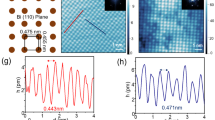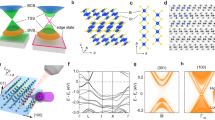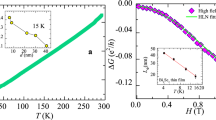Abstract
Dual topological materials are unique topological phases that host coexisting surface states of different topological nature on the same or on different material facets. Here, we show that Bi2TeI is a dual topological insulator. It exhibits band inversions at two time reversal symmetry points of the bulk band, which classify it as a weak topological insulator with metallic states on its ‘side’ surfaces. The mirror symmetry of the crystal structure concurrently classifies it as a topological crystalline insulator. We investigated Bi2TeI spectroscopically to show the existence of both two-dimensional Dirac surface states, which are susceptible to mirror symmetry breaking, and one-dimensional channels that reside along the step edges. Their mutual coexistence on the step edge, where both facets join, is facilitated by momentum and energy segregation. Our observation of a dual topological insulator should stimulate investigations of other dual topology classes with distinct surface manifestations coexisting at their boundaries.
This is a preview of subscription content, access via your institution
Access options
Access Nature and 54 other Nature Portfolio journals
Get Nature+, our best-value online-access subscription
$29.99 / 30 days
cancel any time
Subscribe to this journal
Receive 12 print issues and online access
$259.00 per year
only $21.58 per issue
Buy this article
- Purchase on Springer Link
- Instant access to full article PDF
Prices may be subject to local taxes which are calculated during checkout




Similar content being viewed by others
Data availability
The data that support the plots within this paper and other findings of this study are available from the corresponding author upon reasonable request.
References
Hasan, M. Z. & Kane, C. L. Colloquium: topological insulators. Rev. Mod. Phys. 82, 3045–3067 (2020).
Qi, X.-L. & Zhang, S.-C. Topological insulators and superconductors. Rev. Mod. Phys. 83, 1057–1110 (2011).
Hsieh, D. et al. Observation of unconventional quantum spin textures in topological insulators. Science 323, 919–922 (2009).
Fu, L., Kane, C. & Mele, E. Topological insulators in three dimensions. Phys. Rev. Lett. 98, 106803 (2007).
Fu, L. Topological crystalline insulators. Phys. Rev. Lett. 106, 106802 (2011).
Zeljkovic, I. et al. Dirac mass generation from crystal symmetry breaking on the surfaces of topological crystalline insulators. Nat. Mater. 14, 318–324 (2015).
Slager, R. J., Mesaros, A., Jurici, V. & Zaanen, J. The space group classification of topological band-insulators. Nat. Phys. 9, 98–102 (2013).
Rauch, T., Flieger, M., Henk, J., Mertig, I. & Ernst, A. Dual topological character of chalcogenides: theory for Bi2Te3. Phys. Rev. Lett. 112, 016802 (2014).
Niu, C. et al. Robust dual topological character with spin-valley polarization in a monolayer of the Dirac semimetal Na3Bi. Phys. Rev. B 95, 075404 (2017).
Facio, J. I. et al. Dual topology in jacutingaite Pt2HgSe3. Phys. Rev. Mater. 3, 074202 (2019).
Lau, A., Koepernik, K., van den Brink, J. & Ortix, C. Generic coexistence of Fermi arcs and Dirac cones on the surface of time-reversal invariant Weyl semimetals. Phys. Rev. Lett. 119, 076801 (2017).
Sheng, X. L., Yu, Z. M., Yu, R., Weng, H. & Yang, S. A. d Orbital topological insulator and semimetal in the antifluorite Cu2S family: contrasting spin helicities, nodal box, and hybrid surface states. J. Phys. Chem. Lett. 8, 3506–3511 (2017).
Grushin, A. G., Venderbos, J. W. F. & Bardarson, J. H. Coexistence of Fermi arcs with two-dimensional gapless Dirac states. Phys. Rev. B 91, 121109(R) (2015).
Rusinov, I. P. et al. Mirrror-symmetry protected non-TRIM surface state in the weak topological insulator Bi2TeI. Sci. Rep. 6, 20734 (2016).
Zeunger, A. et al. Synthesis, crystal and topological electronic structures of new bismuth tellurohalides Bi2TeBr and Bi3TeBr. Chem. Mater. 30, 5272–5284 (2018).
Eschbach, M. et al. Bi1Te1 is a dual topological insulator. Nat. Commun. 8, 14976 (2017).
Savilov, S. V. et al. New subvalent bismuth telluroiodides incorporating Bi2 layers: the crystal and electronic structure of Bi2TeI. Russ. Chem. Bull. 54, 87–92 (2005).
Tang, P. et al. Weak topological insulators induced by the interlayer coupling: a first-principles study of stacked Bi2TeI. Phys. Rev. B 89, 041409 (2014).
Zeugner, A. et al. Modular design with 2D topological-insulator building blocks: optimized synthesis and crystal growth and crystal and electronic structures of BixTeI (x = 2, 3). Chem. Mater. 29, 1321–1337 (2017).
Drozdov, I. K. et al. One-dimensional topological edge states of bismuth bilayers. Nat. Phys. 10, 664–669 (2014).
Murakami, S. Quantum spin Hall effect and enhanced magnetic response by spin–orbit coupling. Phys. Rev. Lett. 97, 236805 (2006).
Ringel, Z., Kraus, Y. E. & Stern, A. The strong side of weak topological insulators. Phys. Rev. B 86, 045102 (2012).
Fulga, I. C., Avraham, N., Beidenkopf, H. & Stern, A. Coupled-layer description of topological crystalline insulators. Phys. Rev. B 94, 125405 (2016).
Schindler, F. et al. Higher-order topological insulators. Sci. Adv. 4, eaat0346 (2018).
Langbehn, J., Peng, Y., Trifunovic, L., von Oppen, F. & Brouwer, P. W. Reflection-symmetric second-order topological insulators and superconductors. Phys. Rev. Lett. 119, 246401 (2017).
Benalcazar, W. A., Bernevig, B. A. & Hughes, T. L. Electric multipole moments, topological multipole moment pumping, and chiral hinge states in crystalline insulators. Phys. Rev. B 96, 245115 (2017).
Roushan, P. et al. Topological surface states protected from backscattering by chiral spin texture. Nature 460, 1106–1109 (2009).
Fu, L. & Kane, C. Topological insulators with inversion symmetry. Phys. Rev. B 76, 045302 (2007).
Yang, F. et al. Spatial and energy distribution of topological edge states in single Bi(111) bilayer. Phys. Rev. Lett. 109, 016801 (2012).
Li, X.-B. et al. Experimental observation of topological edge states at the surface step edge of the topological insulator ZrTe5. Phys. Rev. Lett. 116, 176803 (2016).
Wu, R. et al. Evidence for topological edge states in a large energy gap near the step edges on the surface of ZrTe5. Phys. Rev. X 6, 021017 (2016).
Pauly, C. et al. Subnanometre-wide electron channels protected by topology. Nat. Phys. 11, 338–343 (2015).
Rasche, B. et al. Stacked topological insulator built from bismuth-based graphene sheet analogues. Nat. Mater. 12, 422–425 (2013).
Sessi, P. et al. Robust spin-polarized midgap states at step edges of topological crystalline insulators. Science 354, 1269 (2016).
Baum, Y., Posske, T., Fulga, I. C., Trauzettel, B. & Stern, A. Coexisting edge states and gapless bulk in topological states of matter. Phys. Rev. Lett. 114, 136801 (2015).
Soumyanarayanan, A. & Hoffman, J. E. Momentum-resolved STM studies of Rashba-split surface states on the topological semimetal Sb. J. Electron Spectros. Relat. Phenom. 201, 66–73 (2015).
Turner, A. M. & Vishwanath, A. in Topological Insulators Vol. 6 (eds Franz, M. & Molenkamp, L.) 293–324 (Elsevier, 2013).
Burkov, A. A. & Balents, L. Weyl semimetal in a topological insulator multilayer. Phys. Rev. Lett. 107, 127205 (2011).
Richardella, A. et al. Visualizing critical correlations near the metal-insulator transition in Ga1−xMnxAs. Science 327, 665–669 (2010).
Hashimoto, K. et al. Quantum hall transition in real space: from localized to extended states. Phys. Rev. Lett. 101, 256802 (2008).
Acknowledgements
N.A., H.B., B.Y. and C.F. acknowledge the German–Israeli Foundation for Scientific Research and Development (GIF grant no. I-1364-303.7/2016). H.B. and N.A. acknowledge the European Research Council (ERC, project no. TOPO NW), B.Y. acknowledges support by the Ruth and Herman Albert Scholars Program for New Scientists in Weizmann Institute of Science, Israel. C.F.’s work was financially supported by the ERC Advanced (project no. 742068, ‘TOPMAT’). A.Z. and A.I. acknowledge the German Research Foundation (DFG) in the framework of the Special Priority Program 1666 ‘Topological Insulators’ (IS 250/1-2) and Würzburg–Dresden Cluster of Excellence ct.qmat (EXC 2147, Project id 39085490). We are grateful to A. Stern for fruitful discussions and to H. Eizenshtat for his contribution to the measurements.
Author information
Authors and Affiliations
Contributions
A.K.N., A.S. and A.N. acquired the data and performed the analysis. Y.Q., A.I., A.Z. and L.P. grew and characterized the samples. H.F., Y.S. and B.Y. calculated the ab initio model. C.F., H.B. and N.A. conceived the experiment and wrote the manuscript.
Corresponding author
Ethics declarations
Competing interests
The authors declare no competing interests.
Additional information
Publisher’s note Springer Nature remains neutral with regard to jurisdictional claims in published maps and institutional affiliations.
Supplementary information
Supplementary Information
Supplementary Figs. 1–9.
Rights and permissions
About this article
Cite this article
Avraham, N., Kumar Nayak, A., Steinbok, A. et al. Visualizing coexisting surface states in the weak and crystalline topological insulator Bi2TeI. Nat. Mater. 19, 610–616 (2020). https://doi.org/10.1038/s41563-020-0651-6
Received:
Accepted:
Published:
Issue Date:
DOI: https://doi.org/10.1038/s41563-020-0651-6
This article is cited by
-
Dislocation Majorana bound states in iron-based superconductors
Nature Communications (2024)
-
Two-dimensional rectangular bismuth bilayer: A novel dual topological insulator
Frontiers of Physics (2023)
-
Critical topology and pressure-induced superconductivity in the van der Waals compound AuTe2Br
npj Quantum Materials (2022)
-
Freestanding few-layer sheets of a dual topological insulator
npj 2D Materials and Applications (2021)
-
Trapped fractional charges at bulk defects in topological insulators
Nature (2021)



